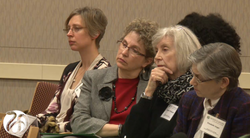
Unfortunately, the IOM committee (non-expert members) showed virtually no interest in any of the presentations, in spite of the fact that they had been submitted well in advance. This should have given committee members ample time to examine the documents and material submitted, and to come up with questions.
There was only one question posed by a non-expert panel member. In response to Charmian Proskauer's presentation on children and adolescents, Dr. Theodore Ganiats, Executive Director of the UCSD Health Services Research Center, said, "I am intrigued by the idea of trying to diagnose children earlier. But whenever you start diagnosing earlier, you'll have some false diagnoses. If you take it to the extreme, and have it be only one day instead of six months, then you're going to have problems. If you wait six months you're going to have problems. So, the question is if you have any data, or know of any data, on length of time of symptoms, and how well that is correlated with a final true diagnosis."
Aside from the fact that Charmian had only two minutes earlier stated in her summary, "You should add the existing clinical definition for Pediatric ME/CFS to your scope of study" [in reference to Leonard Jason, et al. A Pediatric Case Definition for Myalgic Encephalomyelitis and Chronic Fatigue Syndrome, 2006], it is mind-boggling that a committee formed months ago with the charge of evaluating all existing case definitions for ME/CFS has not yet read them.
Dr. Ganiats' flippant proposal that a diagnosis of ME/CFS could be made after one day not only points to a lack of preparation on the part of the committee, it indicates an underlying attitude: This committee is not going to take us, or the illness, seriously.
That was the attitude also expressed by Dr. Clayton's announcement that "we'll be hearing from ... gosh ... patients." Why should it be remarkable for patients to provide input on a process that will have such a profound impact on their lives? Shouldn't patients have the opportunity to speak to that process? And shouldn't their input be welcome?
In a recent blog post, Valerie Eliot Smith observed that "the atmosphere in the room felt sterile, devoid of empathy and compassion... [patients] seemed to be unwelcome and unheard." Astutely, Ms. Smith pointed out that such rigidly imposed restrictions on the amount of time allotted to each presenter acted contrary to First Amendment right to freedom of speech. She asks, "Does a constitutional right to freedom of expression have any meaning in the absence of a subsidiary right to be listened to by the state which should be upholding those rights?"
It is the denial of that right which has led so many patients to boycott the IOM process.
There is an alternative, however: speak louder.
_______________________________________________
This article originally appeared on ProHealth.
Note: You can read a summary of Part 1 of the meeting here.
Part 2 can be found here.
By Erica Verrillo
The second half of the public meeting concerning the IOM’s review of diagnostic criteria for ME/CFS was devoted to presentations by FDA and ME/CFS associations.
Presenters included:
- Sara Eggers, FDA, Voice of the Patient Report
- Lori Chapo-Kroger, PANDORA Org , Let’s Get It Right group
- Mary Schweitzer, for Pat Fero, Wisconsin ME/CFS Association, Inc., Let’s Get It Right group
- Carol Head, CFIDS Association of America, Let’s Get It Right group
- Pat LaRosa, New Jersey Chronic Fatigue Syndrome Association, Inc., Let’s Get It Right group
- Gabby Klein, Phoenix Rising
- Charmian Proskauer, Massachusetts CFIDS/ME & FM Association, Let’s Get It Right group
- Jennie Spotila, OccupyCFS
You can watch presentations HERE.
You can read information about the committee members HERE.
It is not too late to submit comments to the IOM Committee. Send your comments to: [email protected]
________________________________________
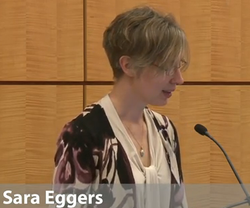
Key message: The key to success is meaningful engagement and valuable input by the patients and the patient community.
Ms. Eggers began by saying that FDA recognizes that CFS and ME is a serious disease, or set of diseases, for which there are no currently approved FDA therapies. “We share in the commitment to facilitate the development of safe and effective drug therapies for CFS and ME,” she stated.
In April of 2013, there was a public meeting to hear perspectives from patients with CFS and ME and patient representatives, and those who care for people with CFS and ME or advocate on behalf of those patients. This was the first meeting conducted as part of the FDA’s Patient Focused Drug Development Program (PFDD). The meeting was part of a larger workshop to explore important issues related to CFS and ME drug development.
Some background on the PFDD initiative
To provide background, Ms. Eggers explained that when the FDA reviews drugs for pre-market approval, it performs a risk/benefit assessment that takes into account a number of factors.
The key decision factors are:
- The analysis of the condition
- The current treatment options
- Benefit, risk, and risk management
FDA typically focuses on obtaining patient input when a specific application is under review. In contrast, PFDD offers a more systematic way of providing patient input on their conditions and treatment options in a broad context.
How FDA chose CFS and ME
In 2012 FDA started the process by nominating disease areas. They got public input through a meeting, through a federal docket, and a federal register notice. Over 4500 comments addressing 90 different diseases were nominated, of which 16 were selected for the first three years of the program. In 2015, they will start another process for the final two years.
The PFDD focused on diseases that are chronic, symptomatic, have few or no effective therapies, etc. CFS and ME fit in many of these categories.
At the meeting for CFS and ME, there was a patient panel for different discussion topics to provide some comments. That was followed with facilitated discussion with the patients in the audience. FDA also had a federal docket that allowed people who could not attend to submit comments.
The meeting resulted in a report that will help FDA staff as they review drugs, as well as when FDA advises drug sponsors in their development program.
Questions posed to patients
- What are the most significant symptoms that you have?
- What impact do they have on daily life?
What are patients’ perspectives on current approaches to treating CFS and ME?
There were 70 patients and patient representatives at the meeting, many on the web. FDA received 228 docket comments, which were detailed and informative.
The report was posted in September of 2013. It is a snapshot of the story that patients collectively told FDA. Though FDA believes the report reflects the content of the meeting and the docket submissions, they stress that the report is not meant to be reflective of the entire patient population.
Key themes
- Abrupt onset, after a specific illness or just waking up one day and not feeling good
- CFS and ME is much more than simply feeling fatigued. More than 50 symptoms were reported, both cognitive and physical manifestations
- Post-exertional malaise or a crash
Patients use a complex regimen of drug and non-drug therapies to treat their disease and manage their symptoms. Over a hundred therapies were mentioned in the meeting or on the docket comments.
They also mentioned a range of diagnostic tools and biomarkers that their clinicians use to help treat their condition. They talked about the varying degree of effectiveness of their treatments, and how their treatments are often associated with bothersome side effects which can exacerbate other aspects of their disease, making treatment a very complex endeavor.
They are desperate for research and development of CFS and ME treatments, at a minimum to relieve their most significant symptoms, but ideally to address the underlying cause or causes of their disease.
Specifics
Cognitive impairment: Impaired executive functioning, or “brain fog,” was frequently mentioned, as were disorientation, inability to process information, slowed reaction times, word-finding difficulties, etc.
Fatigue: This symptom encompassed lack of energy, weakness, exhaustion, feeling drained or difficulty recovering their strength, feeling tired but wired, and feeling extreme bone-crushing fatigue.
Sleep dysfunction: Insomnia, sleep disruptions, having difficulty staying asleep or waking up feeling unrefreshed or not rested can exacerbate their other symptoms, but even with 10,12, or more hours of sleep patients still wake up feeling unrefreshed. Sleep medications often exacerbate fatigue.
Chronic pain: Muscle pain, burning muscles, muscle spasms, joint pain, pain in the eyes, pain behind the eyes, neck pain, nerve pain, neuropathy, headaches and migraines, and whole body pain were mentioned. Patients expressed concern about the lack of knowledge about the fundamental causes of their pain. A few commented that they have fibromyalgia, but they didn’t attribute all of their pain to that. They commented again on the challenge of finding the right treatments for their pain.
Sensitivity to light, sound, and temperature and other stimuli: For some patients, this is their most debilitating set of symptoms. It limits their ability to engage in social interactions or go outside.
Other symptoms included sore throat, flu-like symptoms, orthostatic intolerance, other issues related to blood pressure drops, susceptibility to viral and other infections, GI and vision problems.
PEM: The “crash” is the incapacitating exacerbation of all symptoms that can occur with even minimal exertion and without warning. There is a difference between a physical crash and a cognitive crash. The physical crash is your body feeling like you can’t move. The cognitive crash where your mind feels like you can’t think.
Patients described best days and worst days in great detail. One of the surveys submitted to our docket reported that on “best days” 67 percent of the survey respondents could do light housework or could work part-time on some household tasks, versus 6 percent who could not. On the worst days, 61% reported being bedbound.
In conclusion, this meeting demonstrated that CFS and ME is a debilitating disease that can have a devastating impact on patients’ lives. Patient input strengthens understanding of the specific symptoms that matter most to patients, the burden that this disease has on patients and their families, the range of treatments that are currently being used, and how well those treatments are currently meeting their needs.
Ms. Eggers described the key to success as being “meaningful engagement and valuable input by the patients and the patient community.”
Q&A
Ellen Clayton: Do you have the primary data that the committee can have access to as well?
Ms. Eggers: The primary data is in the form of a transcript, which is available, and public docket comments. One challenge is that not all of the public docket comments were actually put on the website. So I would have to look into seeing how we can make those accessible. That’s the raw data.
Lily Chu: I just have a comment. Dr. Eggers gave some of the results of a survey regarding best and worst days. And if the committee wants that data, Dr. Jason and I conducted that survey, and we can share it with the committee.
Ms. Eggers: Two of the submissions to the docket comments were surveys that were conducted by patient stakeholders and submitted to us through the docket, and we treated them as a piece of input, like the docket comments.
Nancy Klimas: Another comment that came up at the FDA meeting is that the PatientsLikeMe site also has a huge data set on symptoms and even outcomes. There are more than seven thousand patients, I think, right now.
Rick Erdtmann: I just have one quick question. You mentioned at the beginning of your presentation that there was a second report more technical that was in process. When will that be done and will it be publicly available?
Ms. Eggers: That report will be a summary report of the second day of our workshop, which covered technical discussions. That should be posted as soon as it’s available.
____________________________________________
Remarks from ME/CFS Advocates and Associations

PANDORA Org submitted two written comments to the IOM committee for the public meeting. 1) The Needs of the Severely Ill has pictures to show how people suffer with this illness, and 2) Critique of the NICE Guidelines. (Transcripts HERE.)
- Needs of the Severely Ill: http://bit.ly/1dXFxFd
- Critique of the NICE Guidelines (2007): http://bit.ly/1flSfKL
We are all concerned that this process will further set back patient care, and we are concerned that history will repeat itself and patients will end up in a worse position. In the real world, ME/CFS is used as a wastebasket diagnosis. It’s time to take us out of the wastebasket.
Fatigue is a symptom, not an illness. Fatigue is the 7th most common symptom reported to doctors. Fatigue is also experienced by healthy people, and it can result from virtually every physical or psychological illness. These conditions are not under one big “chronic fatigue umbrella,” because fatigue is a symptom of so many diseases.
The main problem in a clinical setting of a fatigue-based definition is that doctors confuse chronic fatigue with chronic fatigue syndrome. They diagnose patients who have primary psychiatric disorders with CFS, and are not educated in illness severity. They prescribe physical therapy and exercise that worsen patient outcomes. They don’t have specialists to send patients to, and they fail to diagnose the disease.
There are some case definitions that are very broad, where the only criteria is that patients have six months of fatigue and a few other symptoms, and others, like the Canadian Consensus Criteria that are concise. But the multiple definitions and the overly broad definitions are causing clinician and researcher confusion.
When looking at research in your study we recommend that you reject all research that focuses on, or only requires, chronic fatigue. Those studies do not inform you on our illness. They inform you on a symptom of many diseases.
Some of you may think that a broad definition would be better for patients, because a more focused definition would limit treatment. This isn’t true for ME/CFS because some of the treatments that are prescribed for idiopathic fatigue are harmful for patients. For example, someone who has depression should be exercising more to release endorphins, but someone with ME/CFS will need to be careful to not exacerbate symptoms by exercising.
We need you to develop a definition that distinguishes between primary depression, idiopathic fatigue, and other organic diseases. Why? Because we want the right treatment. We need a definition narrower than Fukuda and Oxford to eliminate idiopathic fatigue and primary depression, but balanced enough to include patients that represent a proper cohort.
The case definition drives correct diagnosis, drug trials, classification, disability assessment, research, and will lead to a proper name.
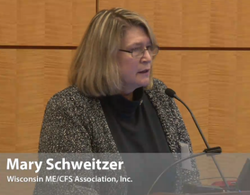
Mary M. Schweitzer, Ph.D., Wisconsin ME/CFS Association, Inc. (Video) (Transcript)
Key message: This is a national public health catastrophe. We need to address it with urgency, not by going back to the drawing board 30 years ago.
Thank you for allowing the Wisconsin ME/CFS Association time to speak; Pat Fero is not here but we worked on this presentation together.
We have known about Myalgic Encephalomyelitis since 1934 (when it was called atypical polio); it was classified as a neurological illness by WHO in 1969.
In the mid-1980s, a series of mysterious cluster outbreaks of the disease occurred around the nation. At first, because many cases seemed to start with a bout of EBV, they called it “Chronic Epstein-Barr Virus,” or CEBV. But common thinking at the time was that you had an acute case of a virus, and then you were immune to it. Barring something like AIDS, there could be no chronic EBV. NIH decided this had nothing to do with the immune system - and that it had nothing to do with EBV.
NIAID's EBV specialist, Stephen Straus, who coined the name CFS in 1986, decided that the disease was somatic (the physical expression of a psychiatric problem) – the result of depression and/or stress. For the next three decades, what little funding NIH allocated went to fatigue studies or studies of stress hormones. As for cluster outbreaks, it was decided they were outbreaks of friendly diagnoses.
At CDC, the first demographic efforts came up with a figure of 10-50,000 patients with CFS, all white upper middle class women. Critics noted that the method CDC used was to ask physicians for information about patients they saw with CFS, which heavily tilted the data set towards those with the means and determination to find someone who could diagnose and treat them.
In 1999, Leonard Jason and a team at DePaul estimated that roughly 800,000 American adults probably had the disease, and the disease affected all income groups and all ethnicities. This estimate has been in use ever since – today, the DePaul estimate would put the number of patients closer to 1.3 million.
In 2003, Canada adopted its version of ICD-10, which included CFS, along with M.E., in neurology. A committee was convened of clinician experts, including several from the US. The result is called the Canadian Consensus Criteria and it does an admirable job of capturing the complexity of this illness.
In 2004, CFSAC recommended to the Secretary of HHS that the US adopt the Canadian Consensus Criteria - and that's when we found out that money allocated to CDC to study young people had been misused.
The money had been spent on closed annual meetings at a resort. According to Dr. Reeves, they had created a new definition for CFS (the “New International Definition”). Comparing the Canadian criteria with Reeves' questionnaires, Jason found that Reeves lost the bottom 30% of patients, while inappropriately including patients with primary mood disorders
Researchers never used the Reeves questionnaires. The funds and the time spent were wasted.
M.E. experts desperately need funding to replicate and further new research on exercise physiology, immunology, virology, genomics, and intricate metabolic research. Please do not repeat the errors of the past – do not waste money on something that researchers do not want and will not use.
A study published in PLoS ONE just over a week ago showed that 3/4 of CFS patients had a deficient EBV-specific B and T-cell response. It appears the dismissal of EBV as having a role in the disease was premature.
Recent research has also shown that 80% or more of CFS patients suffer from chronic infections of CMV, HHV-6, and/or HHV-7. There are new studies on Coxsackie B.
Patients have been found to have abnormal natural killer cell function, abnormal 37kDa Rnase-L, and abnormal cytokine functions. They have abnormal SPECT scans and CPET tests
With so many ongoing research projects, is it any wonder that 50 experts signed a letter asking HHS not to spend one million on this study? If you create a new, more heterogeneous definition and name - let's say, "Multi-system disorder," will applications for NIH research funds and NDA applications require that the researcher meet the new definition? That would set research back terribly.
Now that scientists are again making great breakthroughs, we do not need to descend yet again into a name that implies this is a poorly understood and vague illness having something to do with pain, fatigue, and sleep. We did not need the detour into CFS, and we do not now need a new detour into something like Multi-symptom Disorder.
We need CDC to come out against efforts to portray this illness as psychosomatic, or“factitious illness,” or “factitious illness by proxy,” a euphemism for the discredited Munchausen’s Syndrome by Proxy.” We need CDC to stop suggesting exercise programs.
The government needs to work WITH the experts to find ways to use the biomarkers that have been found, to explain to the world the scientific discoveries that have been made, to fund large studies to confirm or deny the smaller ones. M.E. is NOT a mysterious disease. There is a great deal that is known about it. Listen to the experts.
This is a national public health catastrophe. We need to address it with urgency, not by going back to the drawing board 30 years ago.
Q&A
No questions.
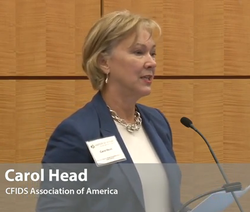
Carol Head, CFIDS Association of America, President and CEO of the CFIDS Association of America (Video) (Transcript)
Key message: Patients wait for years, and see many doctors, before they obtain a diagnosis. We believe that the Canadian Consensus Criteria can be optimized as a clinical case definition by applying a standardized methodology, validation of criteria, and nationwide dissemination to health professionals.
Our involvement in this IOM process stems from our desire to inform the regulatory framework and to accelerate approval of ME/CFS therapies. The development of safe and effective treatments for ME/CFS requires strengthened, uniformly-accepted criteria that can be used consistently by researchers, clinicians and patients. The lack of uniformly-accepted clinical diagnostic criteria is one of many reasons for the slow progress against this illness.
The FDA has stated that, “When there is confusion, lack of consensus and no progress, go back the Core.” The “core” regulatory framework for any disease is: core signs, symptoms or decreases in specific functioning. The FDA recognizes that for ME/CFS, we are still at the very beginning of understanding the core.
We applaud HHS’s effort to address this critically important issue. And at the same time, we anticipate that your work will be extremely difficult, despite your best efforts, as the available research is more limited than any of us would want.
Despite disagreement about the best way forward, we all acknowledge the need for evidence-based, broadly-accepted clinical and research tools that can accurately include or identify all subsets of the heterogeneous group that presents under any of the case definitions of ME/CFS. We believe that the Canadian Consensus Criteria can be optimized as a clinical case definition by applying a standardized methodology, validation of criteria, and nationwide dissemination to health professionals.
This month, the CFIDS Association conducted a survey to understand the patients’ journey with ME/CFS. Of the 256 people who responded, 88% have been diagnosed with ME/CFS by a physician. 32% indicated it took 1 year or less to get a diagnosis, while 36% said it took between 1-5 years, 21% stated it took 5-10 years and nearly 12% waited more than 10 years to be diagnosed. This is a desperately long time to live with pain and impairment, without validation.
Further, the longer it takes to get a diagnosis, the worse a patient gets and becomes more difficult to treat. One of this panel’s charges – to get good diagnostic criteria into the hands of all physicians - is imperative for faster diagnosis and, therefore, better care.
Over and over again, patients told us stories of delayed diagnosis, lack of treatment, a need to educate the doctor, increased disability and even hostility due to physician lack of knowledge and empathy. Patients spoke of the unfortunate ignorance of some in the medical community.
This panel has an opportunity to rewrite that story.
(Read the full survey results HERE.)
And while it’s imperative to develop and disseminate consistent diagnostic criteria, we know that time has not stood still. The few clinicians who specialize in ME/CFS have developed solid intuition and are now treating a few patients to mitigate their symptoms in some cases. This is far from a cure and the situation is not ideal, but treatment is occurring and should not be ignored. Wanting to better understand ME/CFS clinicians’ intuition, in 2012 we conducted a survey asking 25 physicians – all ME/CFS experts – how they treated their patients’ symptoms. [Ms. Head showed a chart of some of the CFIDS Association’s survey results.]
And going even further, good clinical diagnostic criteria will lead to biomarker discovery. [Ms. Head showed a slide of blood samples from the SolveCFS BioBank; the samples were selected using the Canadian Consensus Criteria. The horizontal axis showed 100 different genes and the vertical axis showed whether the sample was from an ME/CFS patient or a control. The majority of ME/CFS patients above the line were distinct from the majority of the controls below. It’s noteworthy that these samples came from patients being cared for by expert ME/CFS physicians – who use current clinical definitions and diagnostic criteria – again demonstrating that clinical diagnostic criteria is possible for ME/CFS.]
The credibility and authority of this IOM committee is important to making ME/CFS widely recognized and diagnosed throughout our nation’s medical community. And that will help the one million Americans who struggle with this serious illness. The success of this committee is of great importance; you have an unprecedented opportunity in the history of ME/CFS.
Q&A
Lily Chu: I wondered if you have any information about duration of illness, and if people who have been sick for a longer period of time had more difficulty getting diagnosed in the past than in recent times.
Ms. Head: I am happy to provide you with the full results of the study, but I don't think it will answer the question you asked. The survey is not longitudinal and we did not explore how long an individual has had the illness.

Pat LaRosa, New Jersey Chronic Fatigue Syndrome Association, Inc. (Video) (Transcript)
Key message: We urge you to adopt the name Myalgic Encephalomyelitis (ME) - a name that is appropriate to the severity of the disease. The name CFS discourages proper coding, and creates numerous obstacles for patients.
Outside the US, the name Myalgic Encephalomyelitis (ME) is accepted internationally, including the World Health Organization (WHO.) In recent years, ME has been accepted by US government agencies, using ME/CFS as the name. Some references might be needed for a time to redirect people to ME, but it is now time to make the change to the single factual name.
In 2011, the name “Chronic Fatigue Syndrome” was rejected by the international panel that wrote Myalgic Encephalomyelitis: International Consensus Criteria. In this document, ME is declared the appropriate name based on "research and clinical experience that strongly points to widespread inflammation and multisystemic neuropathology." It further states, “Using ‘fatigue’ as a name of a disease gives it exclusive emphasis and has been the most confusing and misused criterion.” No other disease adds fatigue to its name.
We urge you to adopt the name Myalgic Encephalomyelitis (ME) - a name that is appropriate to the severity of the disease.
The CDC defined and named CFS in 1988. At that time, the ICD-9 included ME under “Diseases of the Brain.” There was no listing for CFS until 1991, when it was added under “Symptoms and Signs/Malaise and Fatigue.”
In the ICD-10-CM, there two places that ME/CFS might be classified.
- G93.3 ME, CFS, PVFS – "Other Disorders of the Brain", "Diseases of the Nervous System Disorders
- R53.82 CFS - "Symptoms, signs, and abnormal clinical and laboratory findings, not elsewhere classified": "Malaise and Fatigue" "Chronic Fatigue Syndrome, unspecified"
G93.3 - acknowledges neurological pathologies, viral triggers and the relationship of ME, CFS and PVFS. Studies have shown differences between brains of people with CFS, healthy controls and those with psychological disorders. These brain changes justify ME/CFS as a disease of the neurological system. This G code enables patients to receive proper diagnosis, treatment, and disability benefits.
Unfortunately, it is not very well known to physicians and a patient may be coded as having CFS in the R code, instead of ME/CFS in the G code.
The ICD-10-CM is coordinated with the Centers for Medicare and Medicaid Services (CMS) and electronic record keeping. Improper diagnosis can negatively affect the response of doctors reviewing patients' records.
Social Security disability programs use the name “CFS.” Many private long-term disability (LTD) providers follow the SS guidelines and also use “CFS.” Some LTD plans have two-year limits for "mental impairment." A physician using the R code for the vague illness of malaise and fatigue may possibly create an obstacle to obtaining LTD benefits. A diagnosis of ME under the G code would be a definite improvement. The coding issue circles around to the name issue.
These aspects, “name” and “coding,” are of major importance. Please consider these comments as you proceed.
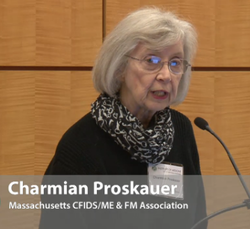
____________________
Charmian Proskauer, Massachusetts CFIDS/ME & FM Association, president of the Massachusetts CFIDS/ME & FM Association (Video) (Transcript)
Key message: A separate clinical definition for pediatric ME/CFS has been developed and should be added to the list of clinical definitions that you consider in your study.
I am here to speak on behalf of children and adolescents with this illness.
Children and adolescents are an important group to consider separately, not merely as a “sub-group” of the adult illness.
- The clinical presentation, while variable, fits into patterns that are described by the existing case definition for pediatric ME/CFS.
- The illness often follows mononucleosis — 13% of mono cases develop into ME/CFS.
ME/CFS is the most frequent cause of prolonged absence from school, and it is this prolonged absence that often leads school officials down the wrong path of falsely labeling ill children with “school phobia” or taking the parents to court for Medical Child Abuse. Children with ME/CFS want to go to school — and will tell you that if you ask them!
The adult definition is not appropriate for children and youth, as the initial presentation of symptoms may be quite different from that of adults. Also it may not be appropriate to ask an ill child to wait until the symptoms have persisted for six months (most of a school year) before receiving a diagnosis which will allow helpful management and treatments to be put in place.
While the onset, symptoms and course of the illness in youth can be quite different from that in adults, as with adults the symptoms vary in nature and intensity on any given day. This variability can cause providers and others uninformed about the illness to believe the symptoms are psychological.
Also as with adults, the illness is usually prolonged, lasting from several years to 10 or more. When a child changes schools, often the process of educating school officials has to start all over again.
The range of issues needing to be dealt with is also different — important aspects for a child include educational needs and social development as well as physical health. Addressing these issues involves the school, the family, and the community, as well as providers of health care.
Families with a chronically ill child already face many challenges. Caring for an ill child who does not have a recognized diagnosis, or with a diagnosis that family, friends, and school officials do not understand, is especially difficult. Without a diagnosis, the more severely ill a child is, the more likely the family will be under pressure from the school and the threat of legal action against them.
Pediatricians, at least in our state, have little knowledge of ME/CFS. When a school nurse recognizes a child with symptoms suggestive of ME/CFS, it is usually very difficult or impossible to find a pediatrician who can make the diagnosis which would allow the child to receive needed educational accommodations and begin appropriate treatment. Lacking a correct diagnosis, there is a significant risk, especially in the case of a severely ill child, that an incorrect diagnosis of Medical Child Abuse or Munchausen Syndrome by Proxy may be given, and the situation may escalate to the point where the child could be removed from the home or legally required to undergo an inappropriate treatment.
On the positive side, outcomes for youth, if good information, treatments, and social and educational support are provided promptly, seem to be better than outcomes for adults. However it should be noted that these studies do not include the most severely ill children, so we do not know the outcomes for them.
In summary:
- We urge this committee to give pediatric ME/CFS sufficient attention during your review.
- You should add the existing clinical definition for Pediatric ME/CFS to your scope of study.
- Your plan to educate physicians should explicitly address pediatricians and school nurses, as well as the providers of adult care. Pediatricians need to be confident in diagnosing this illness as a physical, not psychological, one.
- Please do not defer this; great harm is done every day to children and families due to this lack of knowledge.
- Reviewers need to focus carefully on the case definition used to select patients for the study, since this greatly influences the results of the study. A study group that is overly broad or heterogeneous will lead researchers to incorrect conclusions.
- In any research which discusses psychiatric symptoms (such as depression) in the study group, a careful distinction must be made between pre-existing and post-illness manifestations of the condition. Depression following the onset of ME/CFS often occurs, as it does in many chronic illnesses. Any paper which does not clearly make this distinction is suspect and should be disregarded. Such flawed “research” is responsible for much of the misinformation about ME/CFS being a psychiatric illness, not a medical illness, leading to recommendations of psychiatric care as the primary treatment instead of attempts to treat the underlying medical condition.
- In closing I want to point out that over the years at least some mainstream journals have refused to even consider publishing papers on ME/CFS, regardless of their merit. This has forced ME/CFS researchers to sometimes seek less traditional avenues to publish their work, especially in years past. Please do not overlook these contributions just because they do not appear in the journals you may usually read.
Nancy Klimas: As someone who has dealt with a number of "Munchausen by Proxy" cases in my clinical practice, I can't underscore how devastating it is to a family to see their child literally seized from them. I had one child who was forced into a foster care situation where they did morning calisthenics before he was shipped to school, with devastating consequences.
Theodore Ganiats: I am intrigued by the idea of trying to diagnose children earlier. But whenever you start diagnosing earlier, you'll have some false diagnoses. Because, I'm .. obviously, if you take it to the extreme, and have it be only one day instead of six months, then you're going to have problems. If you wait six months you're going to have problems. So, the question is if you have any data, or know of any data, on length of time of symptoms, and.. uh.. how well that is correlated with a final true diagnosis. [Note: Ms. Proskauer mentioned the existing pediatric definition in both her written comments, as well as those made only a few minutes earlier in her presentation.]
Ms. Proskauer: The existing pediatric definition, which was published by Lenny Jason and colleagues, suggests a three-month waiting period.

Gabby Klein, Phoenix Rising (Video) (Transcript)
Key message: ME is an organic, complex, seriously disabling disease, which needs a definition at least as strict as the CCC or ICC. Myalgic Encephalomyelitis. (ME) should be the term used for the disease.
Thank you for the invitation to speak on behalf of Phoenix Rising. We are a non-profit patient-led organization which hosts the largest online forum for ME/CFS patients.
We have enlisted our members to comment on the question posed by the IOM in their study to recommend clinical diagnostic criteria for ME/CFS:
“What is the most important aspect or information that this committee should consider throughout the course of the study?”
Phoenix Rising members have identified several points of focus:
- ME is an organic, complex, seriously disabling disease
- ME needs a definition at least as strict as the CCC or ICC
- ME is not a psychogenic somatoform illness
- Myalgic Encephalomyelitis (ME) should be the term used for the disease
ME is a complex, severely disabling disease involving multiple systems in the body. It involves extreme muscle weakness, drastic loss of stamina, cognitive dysfunction and viral symptomatology along with neurological and endocrine dysfunction. Fatigue is only a small part and not necessarily the most prominent symptom.
ME needs a definition at least as tight as the CCC or ICC
Most of the experts treating and researching ME have endorsed and are currently using the Canadian Consensus Criteria (CCC). They have recognized that by using post exertional malaise (PEM) as a hallmark of the disease and mandating neurological and immune dysfunction, the CCC best captures the patients who are suffering from this particular disease.
Any new definition for ME must include PEM as a minimal prerequisite for the diagnosis of ME.
The CCC were created to distinguish ME patients from those diagnosed using broad CFS definitions such as the Oxford Criteria of 1991 and the Fukuda Criteria of 1994. These definitions selected many who suffered from vaguely defined idiopathic fatiguing illnesses. These broad definitions have impeded serious research into the complex disease and have held the disease hostage without a chance of effective recognition and advancement.
Studies on the disease have shown that there are testable biomarkers, such as the two-day cardio-pulmonary exercise testing (CPET), which show remarkable abnormalities in ME patients. The fact that PEM/PENE is a hallmark of the disease is no longer debatable. Immune dysfunction has been shown, with multiple studies uncovering defects in natural killer cells in ME patients. Neurological/cognitive dysfunction has been shown by abnormalities in cerebrospinal fluid and structural MRIs.
We therefore ask the panel that the population of severely ill and disabled ME patients should be separated out from the broad fatigue-based definitions, using a definition at least as 'strict' as the CCC or ICC.
ME is not a psychogenic somatoform illness
Terms previously used to describe the syndrome CFS, such as “depressive mood”, “deconditioning”, “somatoform”, “personality disorder”, “childhood abuse”, “hypochondria”, “laziness”, “malingering” or “unwellness” do not apply to the organic disease of ME.
Other illnesses such as Asthma, Stomach Ulcers, Multiple Sclerosis, and Inflammatory Bowel Disease were thought as ‘psychosomatic’ until a known and identifiable physical element was discovered.
Any research into ME as a psychological, psychogenic or functional disorder should be disregarded. Attempts to give a psychiatric or somatization explanation for our illness have utterly failed to explain the realities of the condition, and are incompatible with the details of its progression.
Myalgic Encephalomyelitis (ME) should be the term used for the disease
The term “Chronic Fatigue Syndrome” (“CFS”) is not appropriate for this disease. No disease should be characterized by a symptom shared by many healthy people. Patients with different illnesses and different clinical needs are mixed together under a single ‘CFS’ label. CFS as defined by Fukuda may include people suffering from depression and idiopathic fatiguing illnesses. This leads to confusion in clinical settings often leading to chronic neglect.
ME, as described by the CCC, has a distinct and definable nature. It best describes our members’ complex and specific symptoms of muscular and neurological dysfunctions.
We would like you to know that our members have expressed many concerns about this study, especially the fact that many members of the panel, as currently constituted, lack appropriate expertise in the treatment or diagnosis of this disease.
In addition, there is a large group of stakeholders, experts, advocates and patients who are calling for a cancellation of this study and the adoption of the CCC now. Their concerns are due to the fact that they believe that a new definition can come only from a panel of knowledgeable experts. Some have questioned the legality of the contract as well as the lack of transparency in the actions of HHS. These feelings have resulted in their boycotting these proceedings and choosing not to take part.
Please keep in mind that the recommendations that this study will produce will directly affect the lives of millions of patients worldwide. We hope that you will take the patients’ voice to heart and that you will continue to invite us to be part of the process.
Q&A
No questions.

Jennie Spotila, OccupyCFS (Video) (Transcript courtesy ME/CFS Forums)
Key message: The definition of ME/CFS must be both accurate and precise.
You are facing an enormous challenge, the result of decades of inaccuracy and imprecision in the definition and diagnosis of our disease. I believe the one thing you must keep in mind throughout this study is to be as accurate and precise as you can in order to create sensitive and specific diagnostic criteria.
Multiple names and definitions have been used in the last 30 years, and you should go back as far as the 1950’s to examine the descriptions and definitions of ME. Each definition carries with it a rationale, an associated description of the disease, and a set of limitations. Prevalence rates vary because each definition draws a different circle around – or within – a patient population.
Another challenge is that there are no gold standard biomarkers for the heterogeneous Fukuda population. Despite that, we are very close to establishing one or more diagnostic markers, and a number of you have been responsible for that important research. But the breadth and weaknesses of the case definitions have been a huge obstacle to achieving this.
Finally, as you no doubt realize already, there are competing schools of thought on case definition. Does the mixed bag of definitions describe one disease or more than one disease? How do we identify a more homogenous cohort? What should we call it? Who is competent to diagnose it? We do not agree on the answers to those questions because there are no easy answers.
Potential Pitfalls
As in any controversial subject, there are potential pitfalls that could complicate your work.
First and foremost is the fatigue paradigm. Severe fatigue lasting longer than six months is an extremely common symptom experienced by 4-5% of the general population. One study of newly diagnosed MS patients found that nearly 30% had been diagnosed with severe fatigue or CFS in the three years prior to the MS diagnosis. Because it is based on fatigue, the Fukuda definition has been used as a wastebasket for people with unexplained fatigue, consigning them to medical purgatory when they may have more treatable conditions.
It might help to draw a comparison to chronic pain. While pain conditions are researched across diseases to identify common mechanisms and treatments, we do not define and diagnose them that way. We do not diagnose fibromyalgia, vulvodynia, and migraines as one disease that is subtyped based on where the pain is located in the body because chronic pain is simply too common a symptom. I believe the same is true for the fatigue paradigm. Severe fatigue is simply too common a problem to form the basis of an accurate and precise case definition, regardless of how you try to slice it into subtypes.
Second, it is imperative to recognize which definitions and exclusionary conditions were used in each research study. If you do not take this into account, you will not be able to sort through the evidence with any resulting clarity.
Third, I believe it would be a mistake to lose sight of the impact your report will have in the real world. As Lori and Pat have said, you will have an impact on research and clinical trials. You will have an impact on policy. You will have an impact on clinical care. The stakes are very high, but there is a solution.
Accurate and Precise
I believe it is possible to create diagnostic criteria that are both sensitive and specific for ME/CFS. To do so, you will need to be as accurate and precise as possible.
Start by setting aside the fatigue umbrella, because severe chronic fatigue is common to many diseases, and should not be used as the foundation of a precise case definition. Instead, focus on the core symptoms of disease. Across multiple studies and surveys, post-exertional malaise – not fatigue – has emerged as the key and most disabling feature of this disease. PEM is an exacerbation of multiple symptoms after mental or physical activity, and can be measured through both self-report instruments and objective biological tests. It is also notable for its use in distinguishing between people with ME/CFS and those with major depressive disorder and other illnesses with a fatigue component. Another core symptom identified in the research is cognitive impairment, particularly memory and concentration problems. Unrefreshing sleep and autonomic symptoms also rise to the top. There are many other symptoms as well, but your diagnostic criteria will be more meaningful if you focus on the core features.
Another approach that will help you succeed is to use frequency and severity thresholds, in addition to a list of symptoms, to identify a more precisely defined patient population. In one study, 34% of healthy controls reported at least 4 out of 8 Fukuda secondary symptoms. When higher cutoff thresholds for frequency and severity measures were used, that number dropped to 5%. If you combine a core symptom set with thresholds for frequency and severity of those symptoms, I believe you will be able to establish accurate diagnostic criteria that have high sensitivity and specificity.
Precision is the most important tool at your disposal, and yet it will not remove all ambiguity and uncertainty because there is so much we do not know about this disease. Three hundred years ago, cancer could only be diagnosed when it advanced to externally palpable tumors. The definition of cancer has evolved from the most severe and easily detected form of the disease to the sophisticated detection and subtyping methods of today. Precision based on what we know is the first step.
Conclusion
In summary, you face the enormous challenge of creating diagnostic criteria for a disease with conflicting case definitions, no gold standard biomarkers, and competing views about how to define the problem. You must avoid multiple pitfalls, including the high prevalence of the symptom of chronic fatigue in the general population and the effects of those competing case definitions on research results, and never lose sight of the very high stakes we face. But there is a way for you to overcome all of these challenges, and that is by being accurate and precise.
If you set aside the fatigue umbrella and focus on the core symptoms of this disease, if you establish frequency and severity threshold requirements, and if you recognize that your diagnostic criteria will be part of an iterative process of refinement, then I believe you can create diagnostic criteria that will advance clinical care and research, instead of putting us further behind: a definition that is sensitive and specific to ME/CFS.
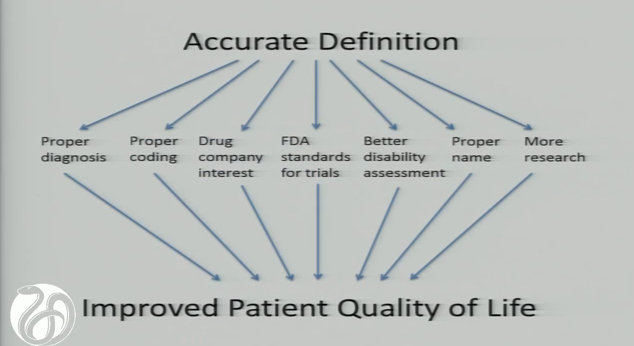
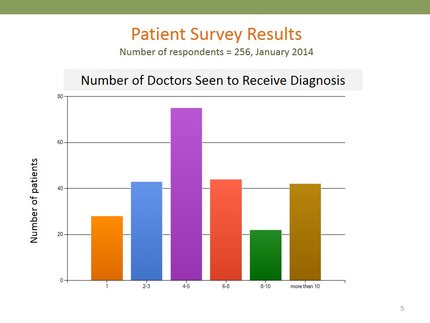
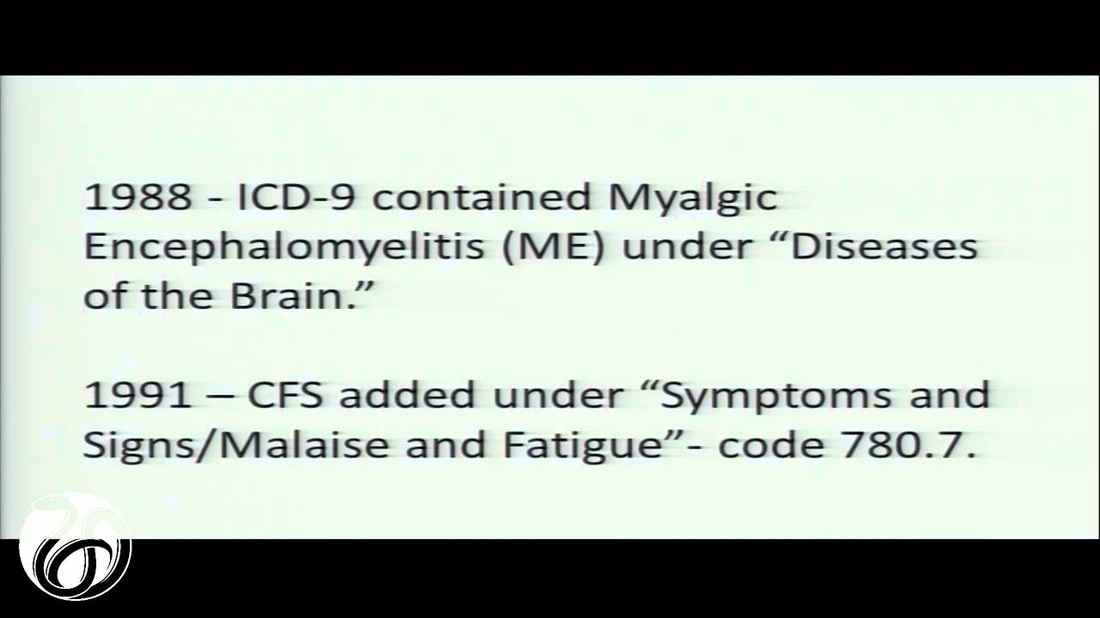
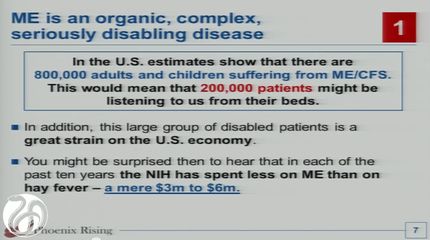

 RSS Feed
RSS Feed
